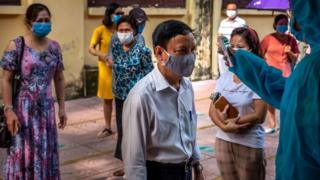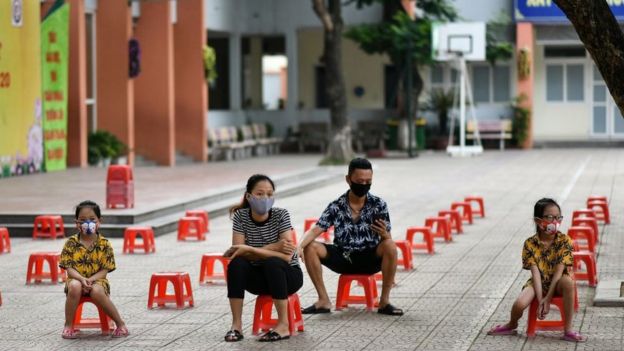Vietnam's COVID Success Curdled
"The government is aware that the health-care system is at risk." "In Danang, doctors and hospital staff have been infected. If medical staff are infected, the pandemic could paralyze the medical system." "The government wants to control the pandemic but also avoid an economic backlash." "The pandemic is a test for the state. During the first wave, Vietnam was quite successful. Now, it's getting quite complicated." Le Dang Doanh, economist, former government adviser, Hanoi
 |
| Returnees from Da Nang are tested for Covid-19 in Hanoi Getty Images |
Vietnam was admired for the way it managed to handle the first wave of the SARS-CoV-2 virus that inundated the world community, handily escaping the loose confines of China, where it originated. As a near geographic neighbour of China, just like Taiwan, Hong Kong and Macau, Vietnam was considered one of the miraculous few countries which seemed to throw a protective shield around itself. Perhaps there's an element of complacency that accounts for Vietnam suddenly being thrown off guard.
As happened elsewhere world wide, where people are tired and fed up of having their freedoms curtailed, of having to negotiate their way around lockdowns, accommodate themselves to a new mode of living; remotely for the most part, observing social distancing, scrupulously observing hygiene modes, wearing uncomfortable masks in public and worrying about contracting a sometimes-deadly pathogen, when strict measures are lifted, the public over-reacts.
COVID-19 may have presented an especial danger to the health-impaired and the elderly -- sometimes one and the same -- but when the younger generation was released from the bondage of social distancing when measures were relaxed in he wake of the first wave passably coming under control, all cautionary devices were thrown to the winds. The result of which was that crowded social venues, parties, beach gatherings began to result in fast-rising numbers of COVID cases among the young.
Admittedly, as a result of their age, less vulnerable by far to the more serious effects of the coronavirus but at the same time, posing the threat of community-based contraction. Vietnam's six-month case statistics where the nation of 96 million posted daily numbers as most countries do, astonished the world at large with no COVID-19 deaths. And then July 31 arrived and suddenly there were ten deaths to report.
Since April 16, with no community transmission cases at all, the coastal city of Danang played unwilling host to an outbreak where the virus swooped through three hospitals, infecting older people with serious health issues. "The coronavirus infection was their last straw", observed Nguyen Gia Binh, head of COVID-19 treatment for the government health ministry, in response to health officials warning of deaths to come.
 |
| Workers prepare a make-shift field hospital inside the Tien Son sports complex amid the spread of the Covid-19 coronavirus in Danang on August 5, 2020. (AFP photo) |
Officials had lifted their strict social-distancing regulations during lockdown, initiated last spring. Once done, people swivelled back to activities like crowding Danang's beaches, leading Prime Minister Nguyen Xuan Phue to observe that the population was letting down its guard. It's not known where the latest swiftly accumulating cases originated, but it took no time spreading to 12 provinces and cities, infecting 298 people.
Guesswork links to a glitch in quarantine, or possibly infections began with an illegal migrant; possibly even the virus leaping from an animal to a human, according to Rogier van Doorn, a clinical microbiologist and director of the Oxford University Clinical Research Unit in Hanoi. Vietnam's experience was as far removed as it could possibly be from that of neighbouring countries like Indonesia and the Philippines, both overwhelmed with fatalities.
As of August 7, Vietnam tallies 750 confirmed cases of the virus, still lower than most countries with like populations. Before the outbreak, the government caught infected individuals, ensuring the health care system was not overwhelmed, so a high level of care could be provided. Now that dozens of cases are presenting and a greater risk of contracting the virus and dying has arisen, there is much to be concerned over.
As a result of the Danang outbreak, authorities have placed 23,356 people in quarantine centres, isolated 6,717 people in hospitals and ordered 140,384 people to home quarantine. Stay-at-home orders were issued as well for Danang and three other regions, while testing is planned for the 1.1 million Danang residents. In Hanoi and Ho Chi Minh City, bars have been closed and large gatherings suspended.
National lockdowns are still unlikely in favour of applying lockdowns to hot spots only. And hoping for the best.
 |
| A family wait to be tested at a makeshift rapid testing centre in Hanoi Getty Images |
Labels: Containment, Global Pandemic, Vietnam

<< Home